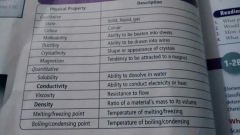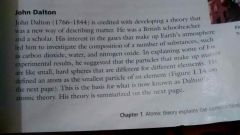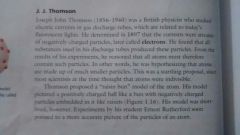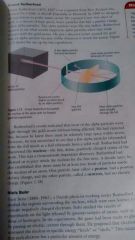![]()
![]()
![]()
Use LEFT and RIGHT arrow keys to navigate between flashcards;
Use UP and DOWN arrow keys to flip the card;
H to show hint;
A reads text to speech;
24 Cards in this Set
- Front
- Back
|
what is matter,mass,and volume?
|
MATTER is anything that has Mass and volume.
MASS is the amount the amount of matter in a substance or object VOLUME is the amount of space a substance or object occupies |
|
|
explain chemical and physical change.
|
Chemical change is a change in matter that occurs when substances combine to form new substances.
Physical change is when there's a change in appearance but no new substances form. |
|
|
what are the three states of matter. and explain them.
|
SOLID =state of matter that has a definite shape and volume.
LIQUID=state of matter that has definite volume, but shape is determined by surroundings. GAS=state of matter that has its shape and volume determined by surroundings |
|
|
what is chemistry, explain.
|
•matter,chemical changes,and states of matter are parts of chemistry
•chemistry includes facts and observations about matter,laws that summarize patterns of behavior in matter,and theories that explain the patterns of matter. |
|
|
state the particle model of matter.
|
1.all matter is made up of very small particles.
2.there are spaces between particles. amount of space between particles differs for different states of matter. 3. the particles that make up matter are always moving. 4.the particles are attracted to one another. strength of attraction depends on type of particle. |
|
|
what is kinetic energy? And explain the kinetic molecular theory.
|
Kinetic energy is the energy of motion
•all particles in every solid ,liquid, and gas are always moving Kinetic molecular theory explains what happens to matter when kinetic energy of particles changes. |
|
|
explain the main points if the kinetic molecular theory.
|
1. All matter is made up of very small particles.
2. there is empty space between particles. 3. particles are constantly moving. In liquids and gases, the particles are colliding with each other and the walls of their container. a) particles of a solid are so tightly packed together that they cannot move freely. they can only vibrate. b)particles of a liquid are farther apart ,and they can move by sliding past each other. c) particles of a gas are very far apart and they move quickly. 4.energy makes particles move.the more energy particles have,the faster they can move and the farther apart they can get. |
|
|
list the temperatures and changes of state.
|
Melting is change of state from solid to liquid
melting point for water is 0°c boiling is the change of state from liquid to gas boiling point for water is 100°c condensation is the change of state from gas to liquid (100°c) Solidification or freezing is the change of state from a liquid to a solid. water solidifies at 0°c |
|
|
changing from a solid to a gas is called...
|
sublimation
|
|
|
changing from a gas to a solid is called...
|
deposition
|
|
|
what are physical properties?
|
characteristics of matter that can be observed or measured.
|
|
|
explain Qualitative properties and Quantitative properties.
|
Qualitative are properties that can be described but not measured
Quantitative are characteristics that can be measured numerically. |
|
|
match the physical properties with their description.
|

|
|
|
what is a pure substance?
|
a substance that is made up of only one kind of matter. Gold, water,and oxygen are example
|
|
|
what are the two types of pure substances?
|
ELEMENT is a pure substance that cannot be broken down or separated into smaller substances.
COMPOUND is a pure substance composed of at least two elements combined in a specific way. |
|
|
explain what John Dalton found out about atoms.
|

atoms that make up gold are different from the atoms that make up lead. atoms cannot be created or destroyed
|
|
|
explain J.J . Thomson's theory.
|

|
|
|
explain Rutherford's theory
|

|
|
|
explain Bohr's theory
|

|
|
|
what is an atom?
|
an atom is the smallest particle of an element that retains the properties of the element.
|
|
|
what are subatomic particles?
|
atoms are made up of three kinds if smaller particles called subatomic particles.
a)protons b)neutrons c)electrons |
|
|
explain electric charge.
|
electric charge comes in two types positive and negative.
protons have a positive charge electrons have a negative charge. |
|
|
explain what a nucleus is.
|
the nucleus is a tiny region at the centre of the atom.
nucleus has a positive charge because of protons. |
|
|
what are electrons
|
electrons occupy special regions called energy levels or shells which surround the nucleus.
|

